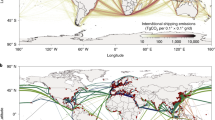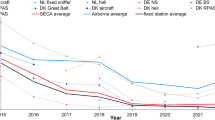Abstract
Global shipping activity emits 938 million tonnes of carbon dioxide annually, surpassing the eighth highest emitting country. Although the impacts from the shipping industry have been investigated over the past three decades, allocating responsibilities remains a difficult issue. Numerous parties should share the responsibility and quantitative analysis is therefore required when considering the interaction between the global economy, shipping and ecological connectivity. Here, beginning with our shipping emission inventory model based on satellite-observed vessel activities, we evaluated trade-embodied shipping emissions and their impacts on human health. Combined with international trade databases, we traced shipping impacts back to responsible bilateral trade and proposed an integrated trade–shipping–air quality–health impact nexus. Quantitative analysis shows that the US–China bilateral trade is responsible for 2.5% of the global shipping carbon dioxide emissions and 4.8% of ship-related global premature deaths caused by air pollution. Our research provides the methodology to allocate intercontinental responsibilities to trade pairs and ships.
This is a preview of subscription content, access via your institution
Access options
Access Nature and 54 other Nature Portfolio journals
Get Nature+, our best-value online-access subscription
$29.99 / 30 days
cancel any time
Subscribe to this journal
Receive 12 digital issues and online access to articles
$119.00 per year
only $9.92 per issue
Buy this article
- Purchase on Springer Link
- Instant access to full article PDF
Prices may be subject to local taxes which are calculated during checkout





Similar content being viewed by others
Data availability
Data are constrained to third-party restrictions. The AIS data and the trade commodity data between China and the US are used under licence for the current study and are not publicly available. Emission data are available from the corresponding author upon request.
Code availability
Python codes used during the current study are available from the corresponding author on reasonable request.
References
World Development Indicators 2015 (International Bank for Reconstruction and Development, 2015).
Third IMO Greenhouse Gas Study 2014 (International Maritime Organization, 2014).
CAIT Climate Data Explorer (World Resources Institute, 2017).
Cames, M., Graichen, J., Siemons, A. & Cook, V. Emission Reduction Targets for International Aviation and Shipping (European Parliament, 2015).
Corbett, J. J. et al. Mortality from ship emissions: a global assessment. Environ. Sci. Technol. 41, 8512–8518 (2007).
Sofiev, M. et al. Cleaner fuels for ships provide public health benefits with climate tradeoffs. Nat. Commun. 9, 406 (2018).
Corbett, J. J. & Fischbeck, P. Emissions from ships. Science 278, 823–824 (1997).
Eyring, V. et al. Transport impacts on atmosphere and climate: shipping. Atmos. Environ. 44, 4735–4771 (2010).
Endresen, Ø. et al. Emission from international sea transportation and environmental impact. J. Geophys. Res. Atmos. 108, 4560 (2003).
Lauer, A., Eyring, V., Hendricks, J., Joeckel, P. & Lohmann, U. Global model simulations of the impact of ocean-going ships on aerosols, clouds, and the radiation budget. Atmos. Chem. Phys. 7, 5061–5079 (2007).
Lund, M. T. et al. Global-mean temperature change from shipping toward 2050: improved representation of the indirect aerosol effect in simple climate models. Environ. Sci. Technol. 46, 8868–8877 (2012).
Winebrake, J. J., Corbett, J. J., Green, E. H., Lauer, A. & Eyring, V. Mitigating the health impacts of pollution from ocean-going shipping: an assessment of low-sulfur fuel mandates. Environ. Sci. Technol. 43, 4776–4782 (2009).
Righi, M., Hendricks, J. & Sausen, R. The global impact of the transport sectors on atmospheric aerosol in 2030. Part 1: land transport and shipping. Atmos. Chem. Phys. 15, 633–651 (2015).
Liu, H. et al. Health and climate impacts of ocean-going vessels in East Asia. Nat. Clim. Change 6, 1037–1041 (2016).
van der Loeff, W. S., Godar, J. & Prakash, V. A spatially explicit data-driven approach to calculating commodity-specific shipping emissions per vessel. J. Clean. Prod. 205, 895–908 (2018).
Oliver, J., Aardenne, J., Dentener, F., Ganzeveld, L. & Peters, J. Recent trends in global greenhouse gas emissions: regional trends 1970–2000 and spatial distribution of key sources in 2000. Environ. Sci. 2, 81–99 (2005).
Wan, Z., el Makhloufi, A., Chen, Y. & Tang, J. Decarbonizing the international shipping industry: solutions and policy recommendations. Mar. Pollut. Bull. 126, 428–435 (2018).
Cadarso, M.-A., Lopez, L.-A., Gomez, N. & Tobarra, M.-A. CO2 emissions of international freight transport and offshoring: measurement and allocation. Ecol. Econ. 69, 1682–1694 (2010).
Faber, J. et al. Aviation and Maritime Transport in a Post-2012 Climate Policy Regime (Netherlands Environmental Assessment Agency, 2007).
Bode, S., Isensee, J., Krause, K. & Michaelowa, A. Climate policy: analysis of ecological, technical and economic implications for international maritime transport. Int. J. Marit. Econ. 4, 164–184 (2002).
National Communication of the Subsidiary Body for Scientific and Technological Advice (Subsidiary Body for Scientific and Technological Advice, UNFCCC, 1996).
Heitmann, N. & Khalilian, S. Accounting for carbon dioxide emissions from international shipping: burden sharing under different UNFCCC allocation options and regime scenarios. Mar. Policy 35, 682–691 (2011).
Faber, J. et al. Technical Support for European Action to Reducing Greenhouse Gas Emissions from International Maritime Transport (CE Delft, 2009).
den Elzen, M. G. J., Olivier, J. G. J. & Berk, M. M. An Analysis of Options for Including International Aviation and Marine Emissions in a Post-2012 Climate Mitigation Regime (Netherlands Environmental Assessment Agency, 2007).
Gay, P. W. & Proops, J. L. R. Carbon-dioxide production by the UK economy – an input output assessment. Appl. Energy 44, 113–130 (1993).
Munksgaard, J. & Pedersen, K. A. CO2 accounts for open economies: producer or consumer responsibility? Energy Policy 29, 327–334 (2001).
Report of the Subsidiary Body for Scientific and Technological Advice on the Fourth Session, Geneva: 16–18 December 1996 (Subsidiary Body for Scientific and Technological Advice, UNFCCC, 1996).
Ahman, M. in Beyond Bali – Strategic Issues for the Post-2010 Climate Change Regime Vol. 11 (ed. Egenhofer, C.) 146–155 (Centre for European Policy Studies, 2008).
Kageson, P. The Maritime Emissions Trading Scheme (Nature Associates, 2008).
Zetterberg, L. in Beyond Bali – Strategic Issues for the Post-2010 Climate Change Regime Vol. 11 (ed. Egenhofer, C.) 156–162 (Centre for European Policy Studies, 2008).
Lin, J. et al. China’s international trade and air pollution in the United States. Proc. Natl Acad. Sci. USA 111, 1736–1741 (2014).
Zhang, Q. et al. Transboundary health impacts of transported global air pollution and international trade. Nature 543, 705–709 (2017).
Wang, H. et al. Trade-driven relocation of air pollution and health impacts in China. Nat. Commun. 8, 738 (2017).
Lenzen, M. et al. International trade drives biodiversity threats in developing nations. Nature 486, 109–112 (2012).
Lv, Z. F. et al. Impacts of shipping emissions on PM2.5 pollution in China. Atmos. Chem. Phys. 18, 15811–15824 (2018).
US International Trade Data (Bureau of the Census, 2019); https://www.census.gov/foreign-trade/data/index.html
Research Report on China–US Economic and Trade Relations (Ministry of Commerce of the People’s Republic of China, 2017).
International Maritime Organization. MEPC 68/INF 24 (Marine Environment Protection Committee, 2015).
World Trade Statistical Review 2017 (World Trade Organization, 2017).
Brooks, A. L., Wang, S. & Jambeck, J. R. The Chinese import ban and its impact on global plastic waste trade. Sci. Adv. 4, eaat0131 (2018).
Announcement on the Issuance of the Catalogue of Imported Waste Management (2017) (Ministry of Ecology and Environment of the People's Republic of China, 2017); http://www.customs.gov.cn/customs/302249/302266/302267/726819/index.html
Note by the International Maritime Organization to the Forty-Eighth Session of the Subsidiary Body for Scientific and Technological Advice (SBSTA48) (International Maritime Organization, 2018).
China Customs Statistics Yearbook 2016 (Chinese Edition) (China Customs Press, 2016).
Overview of the International Shipping Industry: Shipping and World Trade (International Chamber of Shipping, 2005).
Burnett, R. T. et al. An integrated risk function for estimating the global burden of disease attributable to ambient fine particulate matter exposure. Environ. Health Perspect. 122, 397–403 (2014).
Lepeule, J., Laden, F., Dockery, D. & Schwartz, J. Chronic exposure to fine particles and mortality: an extended follow-up of the Harvard Six Cities study from 1974 to 2009. Environ. Health Perspect. 120, 965–970 (2012).
Cohen, A. J. et al. Estimates and 25-year trends of the global burden of disease attributable to ambient air pollution: an analysis of data from the Global Burden of Diseases Study 2015. Lancet 389, 1907–1918 (2017).
Acknowledgements
This work was supported by the National Natural Science Foundation of China (grant nos. 41822505, 91544110, 41571447 and 41625020) and the National Key Research and Development Programme (grant nos. 2016YFC0201504 and 2016YFC0201506). H.L. was supported by the Energy Foundation (grant no. G-1708-26724) and the Beijing Nova Programme (grant no. Z181100006218077). We thank Q. Li, Z. Guo, C. Qu and W. Liu for discussions on statistics.
Author information
Authors and Affiliations
Contributions
H.L. conceived and led the study. Z.-H.M. established the model and the connections between emissions and commodities. Z.-F.L. and F.-Y.D. helped with data processing. Q.Z. and Y.L. performed the GEOS–Chem model simulation. X.-T.W. and Y.-N.Z. helped collect the marine logistics information and process the massive data matching. M.-S.S. worked on the trade dataset. Q.Z. and K.-B.H. provided important views on the study.
Corresponding authors
Ethics declarations
Competing interests
The authors declare no competing interests.
Additional information
Publisher’s note Springer Nature remains neutral with regard to jurisdictional claims in published maps and institutional affiliations.
Supplementary information
Supplementary Information
Supplementary methods, Figs. 1–10, Tables 1–9 and refs.
Rights and permissions
About this article
Cite this article
Liu, H., Meng, ZH., Lv, ZF. et al. Emissions and health impacts from global shipping embodied in US–China bilateral trade. Nat Sustain 2, 1027–1033 (2019). https://doi.org/10.1038/s41893-019-0414-z
Received:
Accepted:
Published:
Issue Date:
DOI: https://doi.org/10.1038/s41893-019-0414-z
This article is cited by
-
Shipping-related pollution decreased but mortality increased in Chinese port cities
Nature Cities (2024)
-
A review on the evaluation models and impact factors of greenhouse gas emissions from municipal solid waste management processes
Environmental Science and Pollution Research (2024)
-
Global gateways as telecoupled human and natural systems: The emerging case of the Bering Strait
Ambio (2023)
-
Estimating the costs and external benefits of reducing shipping-induced air pollution: a case study of Xiamen Harbour, China
Environment, Development and Sustainability (2023)
-
The finest diamond must be green: a closer look at the roles of institution in shipping firms’ sustainable practices
Environmental Science and Pollution Research (2023)



